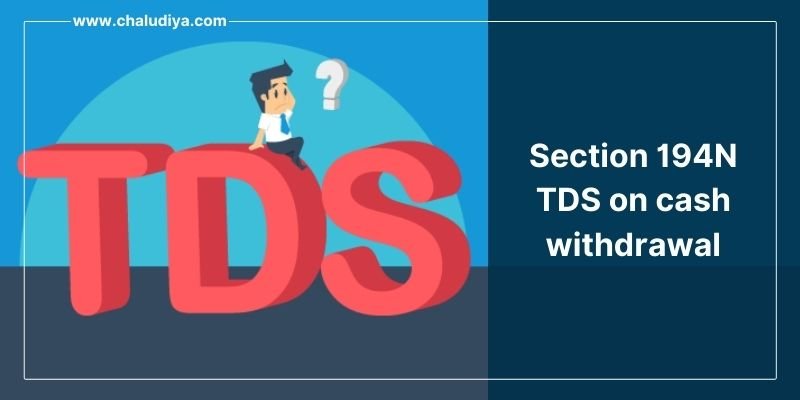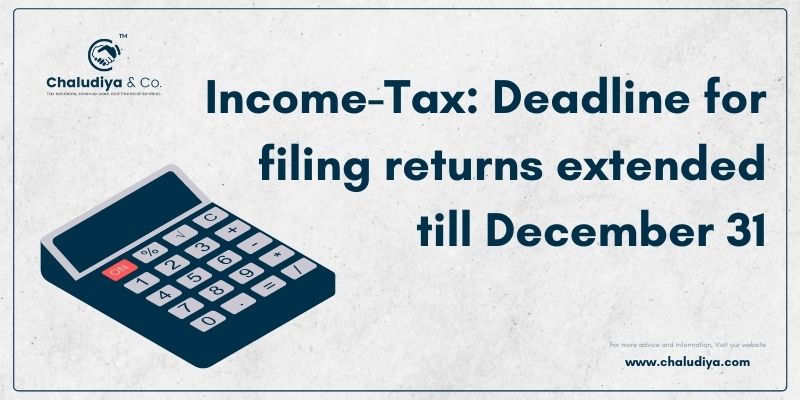- Have any questions?
- +91 76983 15026
- info@chaludiya.com
Section 194N TDS on cash withdrawal

No Late Fees on GSTR 3B for Assessees with NIL Liabilities
July 4, 2020
CBDT allows one-time verification of ITRs of the past 5 years
July 17, 2020Keeping in mind the blueprint of the cashless economy, the BJP-led government is frequently introducing reforms in the laws to achieve the goal. Starting with demonetization, the government has come up with new laws in the constitution which fulfil the purpose of the cashless economy in the nation. Section 194N recently invited in the constitution is yet another move towards promoting digital payments and eradicating cash transactions. The section concentrates on imposing TDS on cash withdrawal exceeding certain threshold limits.
The section serves the objective of eliminating large cash withdrawals from bank accounts and phasing out black money from India. Mentioned below is the detailed scrutiny of the section to give you an idea of its functionality.
Latest Changes in Section 194N Under TDS
The changes done in the section 194N from the FY 2020-21 to be applicable from 1st July 2020:
- If the assessee hasn’t filed the income tax return for the previous 3 financial years the TDS rate will be deducted at the rate of 2% on the amount between INR 20 lakh to 1 crore withdrawn while 5% applicable on the amount exceeding the INR 1 crore of the FY.
- If the assessee has filed the income tax return for the given year, there is no TDS deduction applicable however there will be a 2% TDS deduction on the amount above 1 crore.
Certain conditions for reduced TDS deduction under section 194N:
- The return must be filed within the specified time period along with the income tax returns as per section 139(1).
- Recently registered organization may not be eligible to get the reduced deduction due to the blank previous filing records.
- There must be a declaration provided to the banker/co-operative society which must state the business of banking/post office in order to file the income tax returns of the past 3 FY.
Description – Finance Bill (No. 2), 2019 Dated 5th July 2019
Applicable to an entity who is responsible for paying a sum or aggregate of the sums in cash exceeding Rs. 1 Crore to any individual (recipient) during the previous year. The entity shall deduct the amount equal to 2% of the total sum from the recipient’s authorized account as income tax.
‘The Entity’ may be:
- A banking company which comes under the Banking Regulation Act, 1949 (includes bank or any other financial institution referred to in section 51 of the act)
- A co-operative society indulged in banking processes
- A post office
The sub-section of the law shall not apply on payment made to:
- The Government
- A bank or co-operative society engaged in the business of banking or a post office.
- An entity related to a banking company or co-operative society which is indulged in the business of banking, working in accordance with the guidelines set by Reserve Bank of India under the Reserve Bank of India Act, 1934.
- Any automated teller machine operator or a banking company or co-operative society indulged in the business of banking working in accordance with the laws of RBI mentioned under the Payment and Settlement Systems Act, 2007.
- An individual or a group, Central Government (by an official message in Official Gazette), may appoint in consultation with Reserve Bank of India.
The bill issued by the Lok Sabha on 18 July 2019 declares that TDS will be deducted at the rate of 2% by the bank, co-operative society or post-office indulged in the business of banking, if the aggregate sum of cash withdrawals from the single account goes beyond Rs. 1 Crore.
Advantages of TDS Section 194N
- The section will block the way for huge cash withdrawals and transactions and digital payments will be promoted.
- Tax Department can easily access the data of huge cash transaction and further investigation into the matter related to huge cash transactions.
- The public will boycott the traditional ways of the transaction as the huge cash withdrawals will lead to TDS liabilities.
The objective of digital payments may be achieved with a proper automated system at the same time blocking the way for huge cash transactions.




